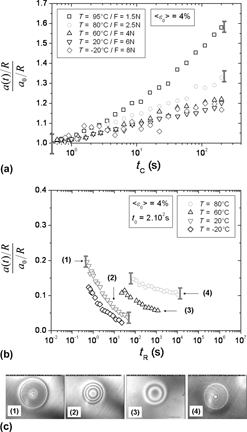Article contents
Original in situ observations of creep during indentation and recovery of the residual imprint on amorphous polymer
Published online by Cambridge University Press: 13 December 2011
Abstract

Creep during loading and recovery phases after load removal are studied using a homemade experimental device that allows us to record in situ the evolution of the true contact area and of the residual imprint versus the time. Indentation tests are performed using a spherical indenter with a tip radius R = 400 μm onto amorphous polymeric surface poly(methylmethacrylate) (PMMA) at different contact durations (10–105 s) and controlled temperatures varying between −20 and 100 °C. Original experimental results are presented about the true evolution of the contact area during creep and recovery phases. An interesting experimental parameter, defined by the ratio a(t)/a0, (with a(t), evolution of the contact radius with creep or relaxation time, and a0, the initial value of the contact radius at the end of the loading phase or at the end of the creep phase) has been introduced to describe the evolution of imposed strain during indentation. As a function of the temperature and of the initial average strain imposed at the end of the loading phase, some nonlinear phenomena can be observed. Using two-dimensional axisymmetric finite element modeling, assuming only viscoelastic behavior, creep and recovering phases during indentation have been reproduced. The simulation results indicate that (i) the test is mainly controlled by the imposed strain and not by the contact pressure, and (ii) some plasticity could appear in the contact zone and as a function of the location and the size of the volume where the strain is maximal, the recovery is more or less limited.
- Type
- Reviews
- Information
- Journal of Materials Research , Volume 27 , Issue 1: Focus Issue: Instrumented Indentation , 14 January 2012 , pp. 12 - 19
- Copyright
- Copyright © Materials Research Society 2011
References
REFERENCES
- 5
- Cited by




